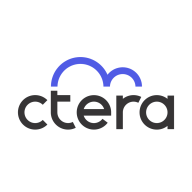

CTERA Enterprise File Services Platform and AWS Elastic Disaster Recovery compete in disaster recovery and file services solutions. CTERA is favored for its pricing and customer support, while AWS stands out for its advanced features.
Features: CTERA Enterprise File Services Platform provides secure file sharing, storage with scalable cloud integration, and strong collaboration features. AWS Elastic Disaster Recovery offers wide-area network optimization, rapid recovery capabilities, and greater control over disaster recovery processes.
Ease of Deployment and Customer Service: CTERA has flexible deployment options with comprehensive customer support, facilitating a smooth transition. AWS offers efficient cloud-based deployment streams, though its customer support is perceived as less hands-on than CTERA's approach.
Pricing and ROI: CTERA offers a competitive pricing structure with high ROI from resource efficiency, making it cost-effective. AWS Elastic Disaster Recovery has higher initial setup costs, but its advanced capabilities provide long-term ROI, justifying the investment for future preparedness.
However, with AWS Elastic Disaster Recovery Service being a native service, integration is seamless, highlighting the return on investment.
Adding SSD storage to Windows file servers is expensive, and we no longer need to back up those devices.
I am positive that CTERA has helped reduce the total cost of ownership by eliminating the need for manual storage management and reducing storage service processes.
In case of any issue, they are ready to provide support within the defined SLA timeline.
They swiftly address concerns and take ownership of the call, providing a very satisfactory support experience.
High-priority issues are handled promptly.
I would rate their support a ten out of ten.
If we need to upgrade CPU and memory, we should be able to do that without a license upgrade.
CTERA is a very scalable product, allowing us to grow.
It offers good scalability options, including vertical and outward scalability.
It is very good and very reliable.
AWS is not difficult, but the cost associated with replicating data to another region can be significant.
It has been pretty stable since then.
We had things deployed for years, and we were suddenly getting cloud sync issues that were crashing our sites.
It is very stable and reliable.
This would detail user activity directly in the ACL console for easier debugging and auditing.
In AWS Disaster Recovery Service, these details are not available, making it difficult to check my replication status.
AI and automation features could enhance the platform, such as AI-powered search, predictive storage analytics, and intelligent alerts for proactive monitoring.
It would help to have a global single-pane-of-glass view of all my CTERA devices.
One suggested improvement for the CTERA Enterprise File Services Platform is the ability to distribute data across multiple active backend storage nodes rather than the current limitation of a single active node.
Unlike other solutions that require hardware purchases, CTERA offers software licensing with flexibility across multiple infrastructure providers.
CTERA's pricing seems to be on par with some of the other players, such as Nasuni and Azure.
I find the pricing reasonable.
AWS Elastic Disaster Recovery Service is a native service, integration is seamless.
As soon as something is written to the device, CTERA copies it to the cloud, where it's versioned with snapshots so we can recover it.
A vital advantage of this platform is its instantaneous recovery capability, allowing seamless access to a secondary gateway if the primary one fails.
It is a three-in-one solution for us. It is a file-sharing platform, an archiving solution, and also a backup solution.


CloudEndure Disaster Recovery enables real-time replication and rapid recovery to enhance organizational resilience. Key features include block-level data replication, ease of use, cost-effectiveness, and automated recovery orchestration. Users benefit from increased efficiency, improved workflows, and enhanced data management, significantly improving organizational performance and business continuity.
The CTERA Enterprise File Services Platform provides a cloud-native global file system over public and private object storage, revolutionizing the world of hybrid cloud data solutions. Enhanced by a rich data services ecosystem, CTERA enables enterprises to gain full control of their data for optimal edge performance, data insight, and governance. The platform focuses on security, providing features like data encryption, access controls, and ransomware protection. Centralized management tools enable efficient data control and monitoring. The platform is being used to replace legacy NAS and file servers, especially at remote locations, and simplify backup and disaster recovery of file data while providing the flexibility of multi-cloud deployments with infinite scalability. CTERA is at the core of hybrid cloud transformations of some of the world’s largest banks, healthcare organizations, global media groups, and government agencies, in deployments that scale to tens of petabytes.
We monitor all Cloud Backup reviews to prevent fraudulent reviews and keep review quality high. We do not post reviews by company employees or direct competitors. We validate each review for authenticity via cross-reference with LinkedIn, and personal follow-up with the reviewer when necessary.